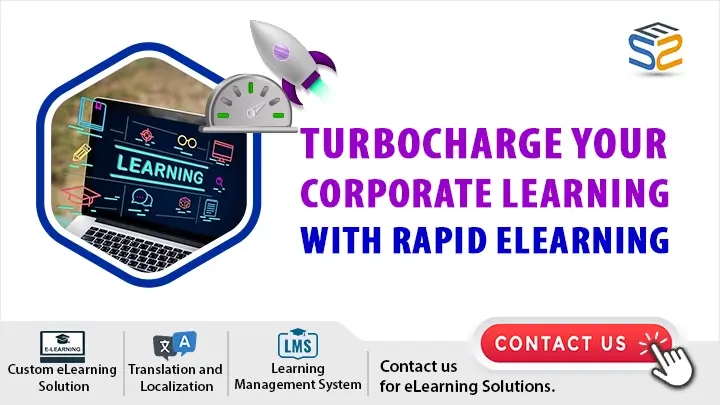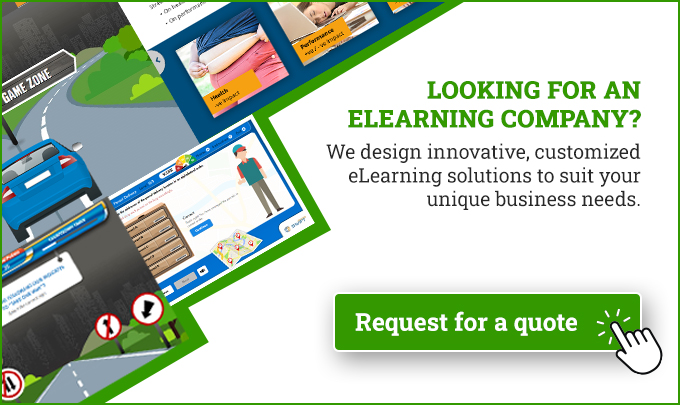Introduction
1. Importance of Corporate Learning in the Modern Business Environment
Corporate learning has evolved from a simple training requirement into a strategic necessity. In a world where change is constant and technology drives innovation, organizations must ensure their employees are continually learning and adapting.
2. The Need for Speed: Why Rapid eLearning is Essential
Traditional training methods often can’t keep up with the speed of business. Rapid eLearning offers a solution by enabling faster development and delivery of training programs, helping organizations maintain a competitive edge.
Understanding Rapid eLearning
1. Definition and Key Features of Rapid eLearning
Rapid eLearning refers to the accelerated development and deployment of eLearning content, typically within weeks or even days. Key features include reusable templates, streamlined processes and the use of authoring tools that require minimal technical expertise.
2. Differences Between Traditional and Rapid eLearning Approaches
While traditional eLearning may take months to develop, rapid eLearning focuses on speed and efficiency, using pre-existing templates and tools to reduce production time without sacrificing quality.
3. Common Myths and Misconceptions
Rapid eLearning is often misunderstood as being low quality or overly simplistic. However, when done right, it can deliver highly effective learning experiences that are both engaging and impactful.
Key Benefits of Rapid eLearning for Corporate Learning
1. Accelerated Training Delivery
Rapid eLearning allows companies to quickly roll out training programs, especially in response to new regulations, product launches, or process changes. This speed ensures that employees are up to date with the latest information.
2. Cost-Effectiveness and Budget Optimization
By reducing the time and resources needed to develop training, rapid eLearning can significantly lower costs, making it an attractive option for budget-conscious organizations.
3. Enhanced Flexibility and Scalability
Rapid eLearning modules are often easier to update and adapt, making them ideal for organizations that need to scale training efforts quickly across different departments or geographies.
4. Improved Knowledge Retention and Engagement
With the incorporation of interactive elements and short content, rapid eLearning can lead to better knowledge retention and higher levels of learner engagement.
Popular Authoring Tools for Rapid eLearning Development
1. Articulate Storyline
Key Features: User-friendly interface, versatile with robust interactivity and multimedia options, supports responsive design.
Best For: Creating complex, interactive courses with branching scenarios.
2. Adobe Captivate
Key Features: Advanced features for responsive design, simulations and mobile-friendly content, strong integration with other Adobe products.
Best For: Detailed and interactive eLearning modules, especially with simulations and complex interactions.
3. iSpring Suite
Key Features: Integrates with PowerPoint, making it ideal for users familiar with Microsoft Office, strong quiz and assessment tools.
Best For: Quick conversion of PowerPoint presentations into eLearning content.
4. Elucidat
Key Features: Cloud-based with a focus on collaboration and responsive design, intuitive interface.
Best For: Teams working together on eLearning projects with an emphasis on responsive design.
5. Lectora
Key Features: Flexible, with strong support for branching and variables, good for creating SCORM-compliant content.
Best For: Detailed and customizable eLearning courses with complex interactions.
6. Gomo Learning
Key Features: Cloud-based, responsive design and easy-to-use, with a focus on mobile learning.
Best For: Creating responsive eLearning content that works well across devices.
7. H5P
Key Features: Integrates with various Learning Management Systems (LMS), offers a wide range of interactive content types.
Best For: Creating interactive content like quizzes, interactive videos and presentations.
8. Camtasia
Key Features: Excellent for screen recording and video editing, easy to use for creating video-based eLearning.
Best For: Developing video tutorials and training materials.
9. Adapt Learning
Key Features: Responsive design, allows for the creation of multi-device eLearning content.
Best For: Teams looking for a flexible solution with strong responsive design capabilities.
Best Practices for Successful Rapid eLearning Implementation
1. Aligning eLearning with Business Goals
Ensure that the eLearning content directly supports your organization’s strategic objectives, whether it’s improving compliance, improving productivity, or enhancing customer service.
2. Ensuring Content Relevance and Quality
Even though speed is a priority, it’s essential to maintain content relevance and quality. Regularly review and update eLearning materials to ensure they meet current business needs.
3. Keeping the Learner Experience Central
Design eLearning content with the end-user in mind. Prioritize usability, accessibility and engagement to maximize the effectiveness of the training.
4. Regularly Updating and Refining Content
Rapid eLearning allows for easy updates. Regularly refresh your training materials to reflect new information, trends, or feedback from learners.
5. Measuring Success and Iterating Accordingly
Use analytics and learner feedback to assess the effectiveness of your rapid eLearning programs.
Future Trends in Rapid eLearning
1. The Rise of AI and Automation in eLearning
AI is set to revolutionize rapid eLearning by automating content creation, personalizing learning experiences and providing real-time analytics.
2. Personalization and Adaptive Learning Paths
Future rapid eLearning strategies will increasingly focus on personalization, allowing learners to follow adaptive paths based on their performance and preferences.
3. Increased Use of Data Analytics for Learning Insights
Organizations will increasingly use data analytics to track learner progress, measure the effectiveness of training programs and identify areas for improvement.
4. Gamification and Immersive Learning Experiences
Gamification and immersive technologies, such as Virtual Reality (VR) and Augmented Reality (AR), will play a larger role in engaging learners and making rapid eLearning more effective.
Our Core Strategies for Implementing Rapid eLearning
1. Efficient eLearning Content Creation
We utilize top-tier eLearning authoring tools like Articulate and Adobe Captivate etc… These tools allow us to rapidly produce high-quality content using pre-built templates and custom designs tailored to your organization’s needs. This approach significantly reduces development time without compromising quality.
2. Optimized Content Development Process
Our team adopts agile methodologies to streamline content development. By breaking down the content into smaller, manageable modules, we ensure faster delivery and the ability to iterate quickly based on feedback. This process not only speeds up development but also ensures that the content remains relevant and impactful.
3. Microlearning for Quick Knowledge Absorption
We specialize in creating microlearning modules that deliver content in short, focused segments. This method allows learners to absorb and retain information more effectively, making training sessions more productive and less time-consuming.
4. Engaging and Interactive Learning Experiences
Our rapid eLearning solutions incorporate interactive elements such as quizzes, simulations and videos, which are designed to engage learners and enhance retention. We use modern tools to develop these elements quickly, ensuring an engaging learning experience without delays.
5. Collaborative and Social Learning Environments
We integrate social learning platforms and collaboration tools into our eLearning solutions. This approach encourages peer-to-peer interaction, discussion and knowledge sharing, enriching the learning experience and fostering a community of continuous learning within your organization.
Summary
Rapid eLearning offers a powerful way to meet the training needs of modern businesses by delivering high-quality content quickly and efficiently. By leveraging the right tools and strategies, organizations can enhance employee performance and stay competitive.
Our Services Are
Custom eLearning Development
We create eLearning courses specifically designed for your needs. From interactive modules to engaging content, we build training programs that fit your organization’s goals and learning objectives.
Learn more about our Custom Elearning Solutions.
Translation and Localization
We translate and adapt your eLearning content for different languages and cultures. This ensures that your training is relevant and accessible to learners worldwide, maintaining its effectiveness no matter where your audience is.
Learn more about our Translation and Localization.
Legacy Content Conversion
We convert your existing training materials into updated eLearning formats. This helps you refresh outdated content and make it more interactive and user-friendly, extending the life of your valuable resources.
Learn more about our Legacy Content Conversion.
Frequently Asked Questions (FAQs)
Q1. What is rapid eLearning?
A. Rapid eLearning is a method of quickly creating and delivering eLearning content using streamlined processes, templates and authoring tools. It focuses on speed and efficiency, allowing organizations to deploy training programs in a matter of days or weeks rather than months.
Q2. Who can benefit from rapid eLearning?
A. Rapid eLearning is beneficial for organizations of all sizes, especially those needing to quickly train large numbers of employees, adapt to new regulations, or update existing training content. It’s also valuable for HR departments, training managers and instructional designers who need to develop training materials swiftly.
Q3. How does rapid eLearning differ from traditional eLearning?
A. Rapid eLearning differs from traditional eLearning in its speed of development and delivery. While traditional eLearning often involves lengthy design and approval processes, rapid eLearning uses pre-designed templates and tools to accelerate content creation, making it a more efficient solution for time-sensitive training needs.
Q4. Why is rapid eLearning important for corporate training?
A. Rapid eLearning is important because it allows organizations to stay agile and responsive to changes. By quickly equipping employees with the necessary skills and knowledge, companies can maintain productivity, ensure compliance and remain competitive in their industry.
Q5. When should rapid eLearning be used?
A. Rapid eLearning is ideal when there’s an urgent need for training, such as compliance with new regulations, onboarding of new employees, or the launch of a new product or service. It’s also useful when frequent updates to training content are required, or when you need to scale training quickly across different locations.







